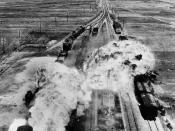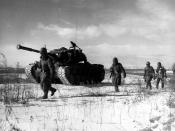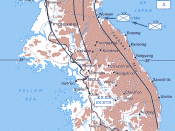The Korean War
The Korean War was a war between North and South Korea. However it was fought between people who wanted Communist rule in Korea versus people who wanted freedom and democracy. It had no winners. All it had was people who lost their lives.
Korea is a peninsula adjacent to China on the west. On the east, across the East Sea lies Japan. Korea is approximately 5000 square miles. It is about the size of Utah and is very mountainous. (Oberdorfer, 3)
In Korea lies the most militarized zone in the world. Called the Demilitarized Zone (DMZ), it lies upon the 38th parallel separating Communist North Korea and Democratic South Korea. (Oberdorfer, 1)
Korea was first taken over by the Japanese during the Russo-Japan War of 1904. After Japan had won, the U.S. approved of Japan's domination of Korea. In return the Japanese promised not to challenge the U.S.'s
dominion over the Philippines. After Japan lost WWII, Korea was freed from Japan. However tensions grew as Russia took over the northern part of Korea up to the 39th parallel. Upon that, Russia placed a communist government in North Korea. South Korea was freed and was expected to become a democracy. It was more or less a fascist government. (Oberdorfer 5-9)
With a North and South Korea in place, more tensions grew as North Korean dictator Kim Il Sung and South Korean President Rhee started civil conflicts upon each other. (Hastings, 51)
On June 25, 1950, around 4:00 AM North Korea attacked South Korea with 135,000 men in the middle of the night. They outnumber the South Korean army, which only had 45,000 men with very little weapons and supplies. Within days, South Korean's army was chopped in half with only half the men accounted for. (Hastings 52-53)
In need of help, South Korean delegates headed to Washington in hopes of getting military support and aid from the U.S. Instead, they were told to ask the U.N. On June 25, a U.N. resolution calling for the withdrawal was passed on a 9-0 vote, which meant military aid for South Korea. (Hastings 55)
With U.N. support, the U.S. aided South Korea in the war effort against North Korea. However, because of demobilization from WWII, the U.S. was heavily unsupplied. Most of their guns were obsolete and most of their equipment was too old to use properly and was more of a hazard to the men using it rather than the enemy it was firing upon. (Hastings, 83)
By July of 1950, the U.N. was fighting in Korea. Most of the men were from the U.S. and U.N. commander in chief was American General Douglas MacArthur. Even with the help of the U.N., North Korean troops overwhelmed the South Korean army causing widespread retreat everywhere to Pusan, a southern city in South Korea. (Korean War History Guide .. The History Beat)
With U.N. troops in Pusan, an attack was coordinated by the North Korean army. This area became known as the Pusan Perimeter. This in essence was the last area to be held by the U.N., and defeating them here would end the war. This would become a very important part and intricate part of the war. (Korean War History Guide .. The History Beat)
The battle for the Pusan Perimeter was a series of battles fought on Pusan to drive the U.N. out of Korea. It began on the night of July 31 after the U.S. led invasion to liberate South Korea. Heavy artillery, support equipment, and armor were unloaded in Pusan. As the U.N. built up to suppress Kim Il Sung's army, they were able to break through. Almost all hope seemed lost as the North Korean army got closer and closer. (Hastings 84-89)
The last ten days of August become the most brutal on the attack on Pusan. The North Korean army was started to reorganize and regroup their troops for a massive attack on U.N. forces. Underwater bridges were constructed to transport tanks and artillery across rivers. Each night there was intense activity on the North Korean front. Guns and ammunition were moved as men dug and labored in deep long trenches preparing for the attack. (Hastings 96)
The attack came on the last night of August. The North Korean army broke through the defenses. It seemed at first that the North Korean army was going to defeat the U.N.; however the North Koreans started losing its power. Soon fighting withered down to petty skirmishes as a few hundred men defended Pusan. (Hastings 98)
As U.N. forces fought on the defensive side, General MacArthur ordered an invasion on Inchon. Inchon was north of Pusan and near Seoul. The invasion was successful and soon MacArthur's forces broke through the North Korean army from its backside. With North Korean forces retreating back north, MacArthur was able to retake Seoul. (Events of the Korean War)
The invasion on Inchon was masterfully designed by General MacArthur. Codenamed Operation Chromite, it was able to drive back the North Korean past the 39th parallel. Now the war was taking place in North Korea. The attack commenced on September 15, 1950. Over 70,000 men carried over 4 carriers and 320 warships invaded Inchon harbor. Within 2 weeks of the invasion, the North Korean army was largely destroyed. (The Inchon Invasion)
The U.N. was on the road to victory until the Chinese became part of the war. The U.N. drove the North Korean army past the 38th parallel and up toward the Yalu River border of North Korea and China. This brought the Chinese into the war. The Chinese had issued warnings that they would react if U.N. forces had reached the Yalu River. On November 1, 1950, U.N. forces reported that they were under attack from unidentified forces. The Chinese had invaded North Korea in hopes of stopping the U.N. (Hastings, 128)
The Chinese invasion brought U.N. troops back to the 38th parallel, where the war had first began. The battle of Chosin Reservoir in winter was a terrible defeat for U.N. troops, mainly the American Marines. By the end of December, the Communists retook Seoul from U.N. forces. Because the situation had became more and more grim, Truman mentioned that atomic weapons may be used. This alarmed everyone. (Korean War History Guide .. The History Beat)
The battle of Chosin Reservoir was a major defeat for U.N. forces. However the Chinese paid a terrible price for this battle. 6,000 U.S. forces were killed and another 6,000 were wounded. 25,000 Chinese forces were killed and another 12,500 were wounded. This battle was one of the bloodiest in the Korean War. U.N. forces were outnumbered 10 to 1. Yet they still fought in hopes of stopping Chinese forces. In the end, the consequences of the battle made it worse off for the Chinese, even though they won the battle. (Hastings 147-156)
By December 1950, General MacArthur, the man who thought of the Inchon invasion, started a campaign to end the war. He believed that the war could not be won, and that it would lead to the inevitable defeat of the United Nations. Daily, he would express exaggerated numbers of how many Chinese troops there were in Korea. He knew that war could not be won if the U.S. did not send over major reinforcements to help with the war effort. The government, instead, told him that no reinforcements would arrive and that he was to maintain a front in "successful positions". MacArthur was soon relieved of command in 1951 by President Harry Truman. It was soon evident that MacArthur was only half right in that the war itself could not be won or lost. It was in a stalemate. (Hastings 192-197)
In April 1951, the Chinese launched another offensive at the U.N. The offensive pushed U.N. forces back to Seoul and resulted in severe casualties. One of the largest obstacles to the advance was the Imjin River held by the British 29th Infantry Brigade. Soon 27,000 Chinese started an attack on the river to get through. Despite being horribly outnumbered, the Brits held off the Chinese off for 4 days. Expecting reinforcements, they defended the river. Soon it was said to them that no reinforcements were coming. With low ammunition, the 29th fought hand to hand with bayonets and fists. Soon they were all captured. About 526 men were captured. 58 were killed. Their struggle delayed the advance of the Chinese for three days. It provided time for the U.N. forces to come together and block the Chinese advance toward Seoul. (Hastings, 218-221)
Throughout the Korean War, war took place on the ground as well as in the air. Places vital to North Korea were bombed heavily. U.S. air forces bombed everything that was available to them like bridges, roads, cities, railroads, etc. However it was useless most of the time. After being bombed, the North Koreans would rebuild everything. Sometimes the bombing would be significant. 10,000 liters of napalm and 679 tons of bombs were dropped on Pyongyang on July 12-13, which killed almost 8,000 people. On June 23, 1952, the Supung dam on the Yalu River, which supplied 90% of the North Korea's power, was destroyed. This caused a blackout for 2 weeks. On May 13, 1953, the Toksan dam was bombed. On May 15-16, the Chasan dam was destroyed. This caused damage to Pyongyang and flooded the cities. It also destroyed many rice crops, which was used for food. This meant starvation for many innocent North Koreans. Bombing was also a form of psychological warfare. It was used to bring down the morale of the North Koreans. (Events of the Korean War)
Battles also took place in the sky. During November 1950, China unveiled its new fighter plane, the MIG-15. Within 6 months, over 435 MIGs were deployed. By the end of the war in 1953, over 830 MIGs were flown by the Chinese. American fighters were no match for the Chinese MIGs. Soon the notable F-80 Shooting Stars became obsolete against the MIGs. Soon F-86 were developed. Nicknamed the Sabre, it helped make the U.N. have superiority in the air. It was reported that in December 1952, 3,997 MIGs had been seen, and 1,849 of them were engaged in combat. 27 were destroyed. (Hastings 258-261)
From mid-1951 to 1953, negotiation for peace treaty stalled and reopened. A major issue that stalled negotiations was whether POWs should be repatriated if they wanted to be repatriated. POWs had been captured on both sides. However the Chinese kept responding that the POWs wished to stay in China. The North Koreans did not have that many POWs because they killed many of them. However, the Korean War was the first major conflict in which the enemy would attempt to convert the prisoner to their beliefs and ideals. The Chinese were successful. 21 Americans and 1 Briton refused to go back at the end of the war. Also, out of the 7,130 prisoners captured by the Communists, 2,730 did not make it back home. Facts show that the Korean War had the highest prisoner death rate out of any war. (Hastings 302-304)
During the Korean War, the people who suffered the most in casualties as well as in pain and suffering were the Koreans. Husbands and wives became separated. Families broke apart. People were being killed here and there under suspicion of being Communist or anti-Communist. Homes were destroyed by U.N. forces to prevent guerrilla's infiltrations. Many North Koreans fled to South Korea because they wanted to survive. By then, they had known that President Truman had thought about using nuclear weapons. They also had a limited supply of food. Daily attacks from bombers also accounted for the large number of North Koreans that fled to South Korea. (Events of the Korean War)
The war in South Korea can be divided into 3 phases. The first phase began on June 25, 1950 and ended when U.N. forces invaded North Korean territory. The second phase was the U.N. front up to China to the retreat from Seoul when the Chinese invaded Korea. The third phase was the stalemate between the Communists and the U.N to the cease-fire agreement unofficially ending the war. (Events of the Korean War)
The treaty to end the Korean War took a very long time. Because of disagreements over how POWs should returned and over accusations of war crimes done by the U.S., treaties stalled until 1953. By June 8, 1953, the disagreement over POWs had settled. It was decided that POWs could voluntarily stay or go back home. On June 17, 1953, an agreement was procured on how and where to split North and South Korea. Everyone was satisfied except for Rhee. Rhee jeopardized negotiations by releasing 27,000 North Korean POWs. This angered the Chinese immensely. In a final offensive, the Chinese attacked U.N. forces for the last time. About 17,000 U.N. troops were killed and 7,400 South Koreans were killed within 20 days of the attack until Rhee accepted the cease-fire agreement. (Hastings 324-326)
The armistice unofficially ending the Korean War was signed on July 27, 1953. The U.N. and the Communists were to pull back 2,000 meters from where they stood and create the Demilitarized Zone (DMZ). (Oberdorfer, 10)
During the war 1,000,000 Chinese soldiers lost their lives. 55,000 Americans were killed in battle. In addition, there were about 4,000 other casualties recorded. Of that 4000, over 700 were British. Over 4,000,000 Koreans from both sides were killed. There were about 40,000,000 Koreans before the war. 2,000,000 of the casualties were civilians. Over 500,000 were soldiers. The rest are unaccounted for. (Events of the Korean War)
The North Koreans viewed the war as a loss for the U.S. Kim Il Sung was quoted on saying, "In the Korean War, the U.S. imperialists suffered an ignominious military defeat for the first time in the history of the U.S.; this means the beginning of a downward path for U.S. imperialism." Soon after, North Korea gained political strength after the war. (Events of the Korean War)
The Korean War was one of the U.S.'s first "Unpopular War". Neither the public nor the military completely understood what had happened. It was also said to be the U.S.'s first defeat in battle. Many others believed that MacArthur should have been kept as Supreme Commander and that he would have won the war. (Events of the Korean War)
The Korean War had no real winners or losers. Boundaries of North and South Korea were very similar after the war. To this day, the war has not ended and North and South Korea are still separated. John Halliday and Bruce Cumings wrote in their book, "Korea: The Unknown War," that "Each side proclaims that it won, yet each actually seems to feel that it lost."
Works Cited Page
Events of the Korean War. February 20, 2003. http://ist-socrates.berkeley.edu/~korea/warevents.html
Hastings, Max. The Korean War. New York. Touchstone. 1987.
Korean War History Guide.. The History Beat. February 16, 2003. http://history.searchbeat.com/koreanwar.htm
Oberdorfer, Don. The Two Koreas. United States of America. Perseus Books Group. 1997.
The Inchon Invasion. February 21, 2003. http://www.kmike.com/inchon.htm



Too factual
You speak in very, very short, and more factual sentences than anything else. You should mix them up, having a few longer sentences and then keep short ones to add power to your meaning. Also a bit too factual, and not enough meaning behind the war.
1 out of 1 people found this comment useful.